| Listing 1 - 10 of 15 | << page >> |
Sort by
|
Multi
ISBN: 9780128133637 0128133635 9780128133620 0128133627 Year: 2018 Publisher: London, England : Academic Press,
Abstract | Keywords | Export | Availability | Bookmark
 Loading...
Loading...Choose an application
- Reference Manager
- EndNote
- RefWorks (Direct export to RefWorks)
The Natural Anti-Gal Antibody as Foe Turned Friend in Medicine provides a comprehensive review of the natural anti-Gal antibody, which is the most abundant antibody in humans constituting ~1% of immunoglobulins and the carbohydrate antigen it recognizes, the?-gal epitope. It discusses the discovery of this antigen/antibody system, its evolution in mammals, the pathological effects of this antibody, and its possible use in various therapies in humans. Most significantly, the book discusses microbial and regenerative therapies in which an antibody present in all humans may be harnessed as an in vivo pharmaceutical agent that enables a wide variety of therapies. Some of these therapies are described as experimental studies that are compiled in this book, other already studied therapies in the area of cancer immunotherapy are also included in this book.
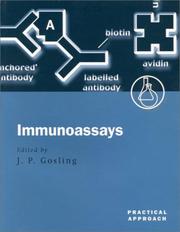
ISBN: 0199637105 0199637113 Year: 2000 Publisher: Oxford : Oxford University Press,
Abstract | Keywords | Export | Availability | Bookmark
 Loading...
Loading...Choose an application
- Reference Manager
- EndNote
- RefWorks (Direct export to RefWorks)
Biological techniques --- Immunology. Immunopathology --- Clinical chemistry --- Anticorps --- antibodies --- Anticorps monoclonal --- monoclonal antibodies --- Antigène --- Antigens --- Réaction antigène anticorps --- antigen antibody reactions --- Immunité --- immunity --- I --- Immunoassay --- 616 --- Immunoglobulins --- Immunology --- Immunodiagnosis --- Immunoassay.
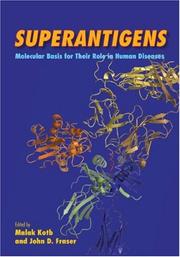
ISBN: 9781555814243 1555814247 9781555815844 1555815847 1283034131 9781283034135 9786613034137 6613034134 Year: 2007 Publisher: Washington : ASM Press,
Abstract | Keywords | Export | Availability | Bookmark
 Loading...
Loading...Choose an application
- Reference Manager
- EndNote
- RefWorks (Direct export to RefWorks)
A team of internationally respected researchers covers the basic molecular mechanisms of superantigen action, their structure and function, and their role in human diseases.
Superantigens. --- Superantigènes --- Immunologie --- Immunology --- Diagnostic de laboratoire --- Laboratory diagnosis --- Maladie de l'homme --- Human diseases --- Antigène --- Antigens --- Réaction antigène anticorps --- antigen antibody reactions --- Immunization --- Superantigènes --- Bacterial antigens --- Viral antigens
Periodical
Abstract | Keywords | Export | Availability | Bookmark
 Loading...
Loading...Choose an application
- Reference Manager
- EndNote
- RefWorks (Direct export to RefWorks)
Antigens. --- Antigen-Antibody Reactions. --- Immunohistochemistry. --- Biogenic amines --- Carotid body. --- Cats --- Rabbits --- Analysis. --- Physiology. --- Histochemistry --- Cytochemistry --- Histochimie --- Cytochimie --- Cytochemistry. --- Histochemistry. --- Cytochimie. --- Histochimie. --- Histocytochemistry --- Cell chemistry --- Biochemistry --- Histology --- Cytology --- Histochemie. --- Cytochemie. --- Histocytochemistry.
Book
ISBN: 9535127276 9535127268 953514152X Year: 2016 Publisher: IntechOpen
Abstract | Keywords | Export | Availability | Bookmark
 Loading...
Loading...Choose an application
- Reference Manager
- EndNote
- RefWorks (Direct export to RefWorks)
Autophagy in Current Trends in Cellular Physiology and Pathology is addressed to one of the fundamental molecular mechanisms - autophagy- evolutionarily adopted by cells for processing of unnecessary or malfunctioned constituents and shaping intracellular structures, adjusting them to environmental conditions, aging, disease, neoplasia, and damages over their life period. Particular attention is paid to autophagy-mediated barrier processes of selective sequestration and recycling of impaired organelles and degradation of invading microorganisms, that is, the processes sustaining intrinsic resistance to stress, tissue degeneration, toxic exposures, and infections. The presented topics encompass personal experience and visions of the chapter contributors and the editors; the book chapters include a broad analysis of literature on biology of autophagy.
Phagocytosis. --- Cytology. --- Autophagy. --- Cell biology --- Cellular biology --- Biology --- Cells --- Antigen-antibody reactions --- Endocytosis --- Immune response --- Immunology --- Phagosomes --- Pinocytosis --- Reticulo-endothelial system --- Tuftsin --- Autophagic vacuoles. --- Autophagocytosis --- Life Sciences --- Microbiology --- Genetics and Molecular Biology --- Cytology --- Biochemistry
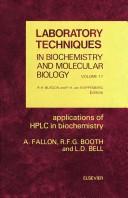
ISBN: 0444821759 9786611759841 0444821767 1281759848 008085897X 9780080858975 9780444821751 9781281759849 9780444821768 0720442001 9780720442007 6611759840 0444802231 0720442222 9780720442229 0720442206 Year: 1999 Publisher: Amsterdam : Elsevier,
Abstract | Keywords | Export | Availability | Bookmark
 Loading...
Loading...Choose an application
- Reference Manager
- EndNote
- RefWorks (Direct export to RefWorks)
This newest edition to the Laboratory Techniques Series gives current state of the art use of synthetic peptides in molecular biology and practical protocols on how to conjugate peptides, immunize animals with peptides and monitor immune responses to peptides in vitro. It gives background information on antigenic specificity, prediction of antigenic sites in proteins and applications of peptides in immunology and virology, as probes in diagnosis and as vaccines. The book also describes antigenicity of proteins and methods to localize antigenic sites as well as methods for predicting epitox
Cell Membrane --- Cytological Techniques --- Mammals --- Specimen Handling --- chemistry --- methods --- Proteins --- Synthetic antigens. --- Antigenic determinants. --- Immunology. --- Animal protein --- peptides --- Binding proteins --- antibodies --- Antigens --- antigen antibody reactions --- Viroses --- diagnosis --- Immune response --- Immunological techniques
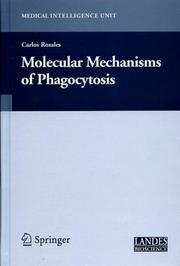
ISBN: 1281309842 9786611309848 0387286691 1423724070 0387254196 1489997636 Year: 2005 Publisher: New York, NY : Springer US : Imprint: Springer,
Abstract | Keywords | Export | Availability | Bookmark
 Loading...
Loading...Choose an application
- Reference Manager
- EndNote
- RefWorks (Direct export to RefWorks)
Although, Phagocytosis was first described nearly 120 year ago, we are just recently beginning to understand the molecules that phagocytic cells use to bring about this complex cell function. Molecular Mechanisms of Phagocytosis was prepared as a series of up-to-date essays (chapters) that describe the present knowledge on the various steps of the phagocytic process from initial cell contact, through internalization of the foreign particle, to the final phagosome formation where the phagocytosed particle is destroyed.
Phagocytosis. --- Antigen-antibody reactions --- Endocytosis --- Immune response --- Immunology --- Phagosomes --- Pinocytosis --- Reticulo-endothelial system --- Tuftsin --- Cytology. --- Oncology. --- Immunology. --- Biochemistry. --- Microbiology. --- Cell Biology. --- Cancer Research. --- Biochemistry, general. --- Microbial biology --- Biology --- Microorganisms --- Biological chemistry --- Chemical composition of organisms --- Organisms --- Physiological chemistry --- Chemistry --- Medical sciences --- Immunobiology --- Life sciences --- Serology --- Tumors --- Cell biology --- Cellular biology --- Cells --- Cytologists --- Composition --- Cell biology. --- Cancer research. --- Cancer research
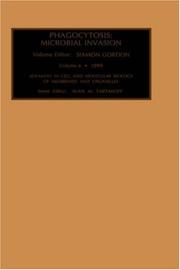
ISBN: 1281060135 9786611060138 008052608X 0762306106 9780762306107 9780080526089 9781281060136 6611060138 Year: 1999 Publisher: Stamford, Conn. JAI Press
Abstract | Keywords | Export | Availability | Bookmark
 Loading...
Loading...Choose an application
- Reference Manager
- EndNote
- RefWorks (Direct export to RefWorks)
The present volume focuses on microbial invasion strategies of pathogen uptake. An accompanying volume (Vol. 5) in the series presents the phagocytic process from the viewpoint of the host cell. This field of study is growing rapidly after a somewhat slow start over recent decades. This collection of invited chapters attempts to reflect current research and brings together cell biologists, microbiologists, and immunologists with disthemes, hopefully like a symphony rather than a boring catalogue. It will be evident that editorial bias favors intracellular parasitism and medically important
Phagocytosis. --- Phagocytes. --- Macrophages. --- Microbial invasiveness. --- Invasion, Microbial --- Invasiveness, Microbial --- Microbial invasion --- Microorganisms --- Virulence (Microbiology) --- Histiocytes --- Mononuclear phagocytes --- Antigen presenting cells --- Connective tissue cells --- Killer cells --- Phagocytes --- Reticulo-endothelial system --- Cells --- Immune system --- Antigen-antibody reactions --- Endocytosis --- Immune response --- Immunology --- Phagosomes --- Pinocytosis --- Tuftsin --- Invasion --- Invasiveness
Book
ISBN: 1489993606 1461471060 1461471079 Year: 2013 Publisher: New York, NY : Springer New York : Imprint: Springer,
Abstract | Keywords | Export | Availability | Bookmark
 Loading...
Loading...Choose an application
- Reference Manager
- EndNote
- RefWorks (Direct export to RefWorks)
This book focuses on the function of antibodies in vivo. Recent years have seen an exponential growth in knowledge about the molecular and cellular mechanisms of antibody activity. These new results dramatically changed our view of how antibodies function in vivo. The importance of this class of molecules is demonstrated by the heightened susceptibility to infections of humans and mice with an altered capacity to generate pathogen specific antibody responses. Thus, the majority of our currently available vaccines, such as vaccines against influenza, measles and hepatitis focus on the generation of long lasting antibody responses. Recent evidence from a variety of in vivo model systems and from human patient cohorts has highlighted the exclusive role of cellular Fc-receptors for certain immunoglobulin isotypes and subclasses. With the recent discovery of a human Fc-receptor for IgM all different human immunoglobulin isotypes now have a cellular receptor, providing a feedback mechanism and link between antibodies and the cellular components of the immune system. Moreover it has become clear the complement and Fc-receptor system are tightly connected and regulate each other to ensure a well balanced immune response. Among the immunoglobulin isotypes IgG plays a very important protective role against microbial infections and also as a therapeutic agent to kill tumor cells or autoantibody producing B cells in autoimmune disease. Transfer of our knowledge about the crucial function of Fc-receptors has led to the production of a second generation of therapeutic antibodies with enhanced binding to this class of receptors. Binding of antibodies to Fc-receptors leads to the recruitment of the potent pro-inflammatory effector functions of cells from the innate immune system. Hence, Fc-receptors link the innate and adaptive immune system, emphasizing the importance of both arms of the immune system and their crosstalk during anti-microbial immune responses. Besides this pro-inflammatory activity immunoglobulin G (IgG) molecules are long known to also have an anti-inflammatory function. This is demonstrated by the use of high dose intravenous immunoglobulins as a therapeutic agent in many human autoimmune diseases. During the past five years several new insights into the molecular and cellular pathways of this anti-inflammatory activity were gained radically changing our view of IgG function in vivo. Several lines of evidence suggest that the sugar moiety attached to the IgG molecule is responsible for these opposing activities and may be seen as a molecular switch enabling the immune system to change IgG function from a pro- to an anti-inflammatory activity. There is convincing evidence in mice and humans that aberrant IgG glycosylation could be an important new pathway for understanding the impaired antibody activity during autoimmune disease. Besides this tremendous increase in basic knowledge about factors influencing immunoglobulin activity the book will also provide insights into how these new insights might help to generate novel therapeutic approaches to enhance IgG activity for tumor therapy on the one hand, and how to block the self-destructive activity of IgG autoantibodies during autoimmune disease on the other hand.
Biology --- Health & Biological Sciences --- Microbiology & Immunology --- Antigen-antibody reactions. --- Immunospecificity. --- Binding sites (Biochemistry) --- Active site (Biochemistry) --- Bonding sites (Biochemistry) --- Reactive site (Biochemistry) --- Immunological specifics --- Serological specificity --- Specificity (Immunology) --- Antibody-antigen reactions --- Medicine. --- Immunology. --- Medical microbiology. --- Virology. --- Biomedicine. --- Medical Microbiology. --- Biochemistry --- Immunoglobulin idiotypes --- Immunospecificity --- Antibody diversity --- Antigenic determinants --- Immune recognition --- Antigens --- Immune response --- Immunoglobulins --- Immunology --- Microbiology. --- Medical virology. --- Medical microbiology --- Virology --- Virus diseases --- Microbial biology --- Microorganisms --- Immunobiology --- Life sciences --- Serology --- Microbiology
Book
ISBN: 9783031217760 Year: 2023 Publisher: Cham, Switzerland : Springer Nature Switzerland AG,
Abstract | Keywords | Export | Availability | Bookmark
 Loading...
Loading...Choose an application
- Reference Manager
- EndNote
- RefWorks (Direct export to RefWorks)
This book is a continuation of the topic of “DAMPs in Human Diseases”, the basics of which were described in a first volume, and details of their role in polytrauma, solid organ injuries, atherosclerosis, and cerebrocardiovascular diseases in a second volume by the same author. The third volume presents our current understanding of the impact of DAMP-driven innate/adaptive immune responses on the etiopathogenesis of antigen-related disorders, focusing on infectious and autoimmune diseases (highlighting respiratory virus diseases such as COVID-19, bacterial sepsis, and malaria) and autoimmune diseases (emphasizing systemic lupus erythematosus, rheumatoid arthritis, multiple sclerosis, type 1 diabetes), and briefly discussing allograft and tumor rejection. The detailed description and illustration of DAMP-triggered inflammatory pathways in the various chapters explain, for example, why it is the dysregulated emission of DAMPs - and not the virus or the bacterium per se- that is responsible for admitting COVID-19 or sepsis patients to the ICU for intensive care treatment. Also, the chapters on autoimmune diseases explain why, mechanistically, environmental factors make up a significant part of the risk in disease initiation and propagation. Our growing understanding of such deleterious pathogenetic functions of activating DAMPs and suppressing DAMPs (SAMPs) is used as a point of departure to explore how these molecules can be used as valuable diagnostic and prognostic biomarkers as well as future therapeutic targets and therapeutics. The book is written for professionals from all medical and paramedical disciplines who are interested in the introduction of innovative data from modern inflammation and immunity research into clinical practice. In this sense, the book reflects an approach to translational medicine. The readership will include all practitioners and clinicians, in particular, ICU clinicians, infectiologists, microbiologists, virologists, hematologists, rheumatologists, diabetologists, neurologists, transplantologists, oncologists, and pharmacists.
Internal medicine. --- Immunology. --- Allergy. --- Natural immunity. --- Internal Medicine. --- Allergology. --- Innate Immunity. --- Allergic diseases --- Allergies --- Hypersensitivity --- Hypersensitivity, Immediate --- Immediate allergy --- Immediate hypersensitivity --- Immunologic diseases --- Immunoglobulin E --- Immunobiology --- Life sciences --- Serology --- Medicine, Internal --- Medicine --- Disease resistance --- Host resistance --- Innate immunity --- Innate resistance --- Native immunity --- Natural resistance --- Nonspecific immunity --- Resistance to disease --- Immunity --- Antigen-antibody reactions. --- Diseases --- Molecular aspects. --- Human beings --- Illness --- Illnesses --- Morbidity --- Sickness --- Sicknesses --- Epidemiology --- Health --- Pathology --- Sick --- Antibody-antigen reactions --- Antigens --- Immune response --- Immunoglobulins --- Immunology
| Listing 1 - 10 of 15 | << page >> |
Sort by
|

 Search
Search Feedback
Feedback About
About Help
Help News
News